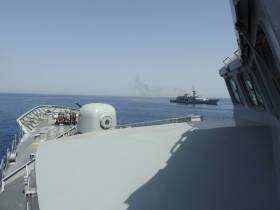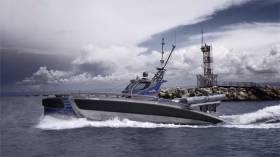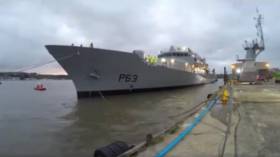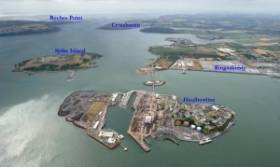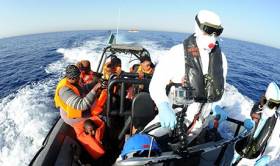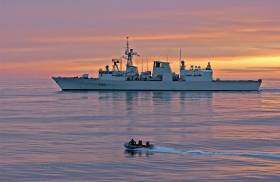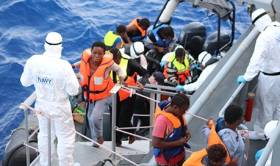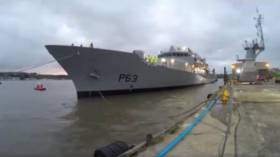Displaying items by tag: Navy
#Rendezvous - L.É. James Joyce which has been tasked to continue humanitarian duties in the Mediterranean made a rendezvous with L.É. Roisin, east of Gibraltar yesterday, writes Jehan Ashmore
OPV LE James Joyce departed the Naval Base, Haulbowline on Friday, to assist the Italian authorities in the continuing search and rescue (SAR) humanitarian operations of migrants off north Africa.
Under command of Captain, Lieutenant Commander Neil Manning and his crew and medical personnel of 59 persons, L.É. James Joyce, is the Navy Service’s newest operational OPV90 class vessel. Next month, a third sister which has undergone trials, L.É. William Butler Yeats is expected to be delivered to Irish waters.
The L.É. Roisin was making a homeward bound voyage from Valetta, Malta. During the meeting, both OPV’s carried out parallel courses for a period and transferred medical and IT equipment.
L.É. James Joyce becomes the fifth ship deployed by the Naval Service to the Mediterranean Sea as part of Operation PONTUS.
#Navy - The future of maritime defence is here – in the form of a torpedo-wielding drone boat called Seagull.
The video below from Vocativ shows a prototype of the 40ft vessel in action, displaying its stealthy manoeuvrability on the water.
Watch video!Developed by an Israeli company, the Seagull is intended for the most dangerous tasks at sea such as minesweeping or anti-submarine missions.
Effectively, just a handful of such boats could replace the work currently done by teams of US Navy destroyers and long-range aircraft.
Popular Mechanics has more on the story HERE.
Opposition to Poolbeg Incinerator After Test Failure
#ConcernsIncinerator - Concerns have been raised over development of Dublin’s Poolbeg incinerator by US waste firm Covanta, writes The Irish Times, following the failure of emissions tests by a Canadian plant built by the company.
Covanta last May had to close one of the two boilers or “stacks” at its newly built Durham York incinerator near Toronto after emissions exceeded the limits set by the Canadian ministry of environment for dioxins and furans by 13 times.
Dioxins and furans are toxic byproducts that can result from burning waste. For more on the concerns raised click here.
While in Cork Harbour, Minister with Responsibility for Defence as stated operational requirements of the Defence Forces will be reviewed, depending Bord Pleanala’s decision on an application by Indaver to build an incinerator at Ringaskiddy. The proposed site is next to the Naval Service base on Haulbowline Island.
#YeatsSeaTrials - Newest Naval Service OPV, L.É. William Butler Yeats (P63) began builder’s sea trials in the Bristol Channel until returning today to Appledore in the UK, writes Jehan Ashmore.
L.É. William Butler Yeats was floated-out in March from Babcock Marine & Technology’s yard at Bidna, Appledore in north Devon. The 1,900 displacement newbuild directly replaces the recently decommissioned L.É. Aisling (P23).
If the series of trails that began on Sunday, proceed according to plan, it is envisaged the OPV90 or 'Beckett' class newbuild will be delivered to the Naval Service base in Cork Harbour next month.
The newbuild represents the third OPV90 in which two such ships were originally ordered by the Irish Government. They are an improved version of the 'Róisín' class.
The successor class are the most sophisticated vessels of the Naval Service. They are equipped with Unmanned Aerial Vehicles (UAV) to carry out tasks in covert surveillence operations among them drug interdiction duties.
As previously reported on Afloat.ie, last month an order for a fourth of the class costing €54.3m (€66.8m after VAT) was contracted to Babcock International, again to the same UK shipyard.
Now that L.É. Aisling (P23) has been taken out of service from what was an eight-strong fleet, the current total is six vessels that is serving in domestic waters.
The seventh vessel L.É. Róisín (P51) since May has been deployed on a humanitarian role in rescuing migrants in the Mediterranean, though she is due to return to Ireland this month in mid-July.
In turn LÉ James Joyce (P62) is due to depart the Naval Base at Haulbowline this Friday. The second of the OPV90 Beckett class is to take over the Irish contribution to the humanitarian mission.
The Minister with Responsibility for Defence has stated that the operational requirements of the Defence Forces will be reviewed, depending on the outcome of Bord Pleanala’s decision on the application by Indaver to build an incinerator at Ringaskiddy in Cork Harbour close to Naval Service operational headquarters on Haulbowline Island.
The Department of Defence has warned that this has strategic implication for the State.
What the Minister means by his statement and what effect it could have on Naval Service operations at their headquarters is unclear.
The Minister was replying in a letter to Independent Dublin TD, Tommy Broughan, who questioned him about the “strategic implications for the Navy” and the impact on joint operations with the Air Corps, which were identified by the Department of Defence at the Bord Pleanala inquiry hearing into the Indaver planning application.
Mr.Kehoe said in his letter “As the planning application on the building of an incinerator in Ringaskiddy is currently under consideration by An Bord Pleanala it would not be useful at this time to consider what the outcome might be. The operational requirements of the Defence Forces will be reviewed in the context of the planning decision however it would be inappropriate to comment further on the matter at this time.”
In a previous response to Deputy Broughan and in a reply by the Taoiseach to Cork TD Mick Barry, Minister Kehoe and the Taoiseach, who is also Minister for Defence, had both acknowledged the Department of Defence concerns but had refused further comment pending the decision of Bord Pleanala.
Minister Kehoe’s second response, to Deputy Broughan, is the first indication that the operations of the Naval Service and Air Corps will be reviewed in the light of the Bord Pleanala decision.
#RoisinRescues - Once again the Naval Service OPV LÉ Róisín has been kept busy having been deployed in successfully locating and rescuing migrants in the Mediterranean Sea.
The operations carried out on Monday involved the saving of 371* migrants in total, following requests organised by the Italian Maritime Rescue Co-Ordination Centre. This saw three separate rubber vessels located 37 nautical miles north-west of the Libyan capital Tripoli.
The first rescue commenced at 6.50am, a total of 114 migrants are now on board and are receiving food, water and medical treatment where required.
LÉ Róisín was immediately re-tasked with the rescue of a further 115 people from a rubber vessel in the same area. All persons were on board by 9.15am.
The final operation search and rescue operation took place again north-west of Tripoli, where a further 142 migrants were taken on board.
*Figures for these operations are provisional until confirmed by the Italian authorities.
#Decommissioning - Minister with Responsibility for Defence, Mr Paul Kehoe, yesterday attended the decommissioning ceremony of LÉ Aisling in Galway Docks.
LÉ Aisling was the longest serving vessel in the Irish Naval Service fleet. The ‘Deirdre’ class vessel built by Verolme Cork Dockyard was also an improved version as the final third ‘Emer’ class. She entered service in 1980.
The decommissioning ceremony took place of LÉ Aisling alongside Molvoy Quay at the port's Dun Aengus Dock. The direct successor will be newbuild OPV90 class LÉ William Butler Yeats which is to undergo builder’s trials next month.
Also previously reported on Afloat.ie the Government has placed an order for a fourth OPV90 'Beckett' class costing €54.3m from Babcock International’s north Devon yard.
In his address Minister Kehoe stated that: LÉ Aisling has been decommissioned after 36 years of outstanding service to the State and noted that during this time she travelled in excess of 628,000 nautical miles, an equivalent of circumnavigating the globe 32 times. Her crew has boarded over 5,500 vessels at sea and detained over 220 fishing vessels.
The Minister recalled that during her service, LÉ Aisling has been involved in many successful operations. The most notable of these include the arrest of the ‘Marita Ann’ in 1984 and her activities as the first vessel on the scene of the Air India disaster in 1985, for which several of her crew were decorated.
The Minister also stated: In pursuit of our commitment to progress the Ships Replacement Programme, the Government has provided a significant increase in capital funding to enhance the capabilities across the Defence Forces. The replacement vessel for LÉ Aisling, LÉ William Butler Yeats is scheduled for delivery shortly and the signing of contracts this week for delivery of a fourth vessel (see above), represent tangible demonstrations of this commitment.
LÉ Aisling is twinned with Galway and has had a long association with the city. The minister also praised the men and women who sailed on LÉ Aisling throughout her years of service, and marked out the great pride they had shown in her close association with the city and the many thousands of euro raised by them on behalf of the Children’s Ward in Galway University Hospital.
#NATOfrigate - A Royal Canadian Navy ‘Halifax’ frigate is to call to Dublin Port next week and which has been deployed on Operation Reasurrance for a NATO Force.
HMCS Frederiction is to join the Standing NATO Maritime Forces fleet based in the Mediterranean Sea. This is part of NATO’s assurance measures, promoting security and stability in Central and Eastern Europe.
The ship will replace HMCS Winnipeg, which has been part of Standing NATO Maritime Forces since July 2015.
HMCS Fredericton will provide Canada the flexibility to execute a range of missions across a broad spectrum of operations in support of Allied efforts in the region, including surveillance and monitoring, regional defence, diplomatic engagement and capacity building.
Operation Reasurrance is HMCS Fredericton’s second deployment in support of NATO assurance measures. It was the first modernized frigate to deploy in support of Government of Canada objectives in 2014.
The Halifax-class modernization/frigate life extension (HCM/FELEX) is a $4.3 billion program to upgrade and enhance the Royal Canadian Navy’s existing fleet of frigates.
The project includes a new Combat Management System, a new radar capability, a new electronic warfare system upgrade, and upgraded communications and missiles, as well as a new Integrated Platform Management System.
LÉ Róisín Rescues Migrants And Recovers Two Bodies
#Rescue&Recovery - OPV LÉ Róisín has carried out a search and rescue (SAR) that located 111 migrants from a long rubber vessel almost 40nm north-west off Tripoli, the Libyan capital. Unfortunately, two deceased female migrants were recovered as part of a request from the Italian Maritime Rescue Co-ordination Centre.
The Naval Service rescue commenced at 06.50am and all migrants were on board by 09.40am and have received food, water and medical treatment where required.
The LÉ Róisín proceeded towards the Port of Lampedusa for the transfer of migrants to the Italian authorities.
Not including this latest task, LÉ Róisín has rescued 782 people since the OPV was deployed on SAR operations on 11 May.
Another Naval OPV90 Vessel Order by State in €200m Deal
#GovOrderOPV - Paul Kehoe, Junior Defence Minsiter has secured Government approval to purchase another OPV vessel for the Naval Service.
This ensures that the service will continue to have at least eight ships while at the same time replacing older vessels.
Mr Kehoe told the Irish Independent last night that the Government had agreed to provide €54.3m ( €66.8m after VAT) the purchase an additional ship after reaching a contract agreement with Babcock International to build it at their headquarters in Appledore, Devon.
He said: "This is a major benefit to the State and will be a further significant enhancement of defence capability. "The acquisition of a fourth sister ship of the same class as those recently commissioned will secure crewing, training, logistical and maintenance advantages", he added.
The new ship will be delivered within two years and its purchase is in line with the maritime capability requirements set out in the government white paper on defence last year.
For more The Independent has a report here.


























